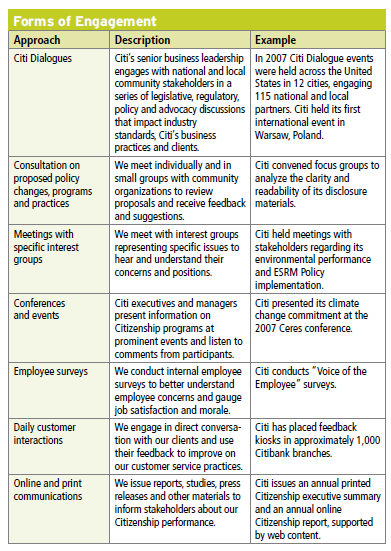![]()
Last November Two Tomorrows published their 2012 Tomorrow’s Value Research report.
It was a bit of an eye opener.
The drive for transparency, the report concluded, is distracting businesses from tackling issues and many risk losing sight of the overall sustainability picture.
A telling statistic is that only half the Dow Jones Sustainability Index (DJSI) supersector members measured up to Two Tomorrows’ “leadership” criteria. You would have expected these to be unanimously in the vanguard.
To try and galvanise the remaining companies, the report seized upon seven areas of best practices they had come across, which are repeated here with a website gloss on them.
Stakeholder Engagement
 Citibank are well known for their stakeholder engagement and to the right is a table they produced in 2007 which neatly summarises what they do, how they do it and with whom.
Citibank are well known for their stakeholder engagement and to the right is a table they produced in 2007 which neatly summarises what they do, how they do it and with whom.
In essence you need to embrace all your stakeholders and be prepared to use whatever fora are suitable in whichever circumstances. The key is always to make sure the engagement is a process, not a one off event.
The challenge from a website point of view is how to knit all this disparate activity together into a whole. Giving categories and examples, as Citi do in their report, is a good way and the value of video clips with stakeholders cannot be underestimated.
Target Setting
Ford’s SMART targets cover six key areas: finance, environment & climate change, water, product (ie. vehicle) safety, supply chain and health & safety.
They’re nicely presented on the website in an interactive tabbed chart which displays what each target is, what the current progress is and whether the target is on track, not on track, or in progress.
However the best thing about Ford’s targets is that they demonstrate that breadth Two Tomorrows is saying businesses need to keep sight of, bringing together everything from manufacturing capacity to human rights in their supply chain in one place.
Innovation
GE gets high praise for its ecomagination programme, not just because it embeds sustainability firmly within its R&D process but also because it embraces its stakeholders in the process. The key here is not just to do business sustainably, but to actively be a sustainable business in all you do and say.
Competition and innovation are the nature of business and in truth, in these early days of sustainable business, all you have to do to become a leader in your field in ensure sustainability is woven into this fundamental fabric of your business.
For many emulating this on a website can be as easy as putting it into a policy and ensuring it is part of the innovation process, whether you deal in good or services. Once this is done then the sustainability benefits will start to manifest into a much fuller story as each innovation cycle progresses.
(This post continues in part two, which can be read here).
Picture Credit: The Night Lights of Europe / Woodley Wonder Works / CC BY. Hat tip to NASA.
A former CTO, Chris has a broad and varied background. He’s been involved with blue chips, consultancies & SMEs across a wide variety of sectors and has worked in Europe, the Middle East and Australia.
In 2007 he decided to combine his knowledge of business and IT with his passion for all things sustainable and has been busy writing ever since. However, his greatest ambition remains to brew the perfect cup of coffee.
